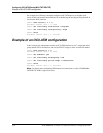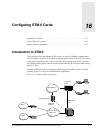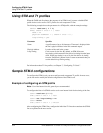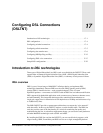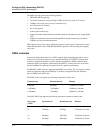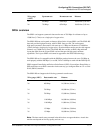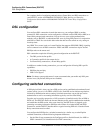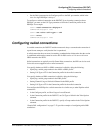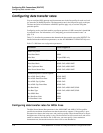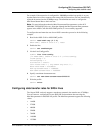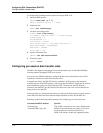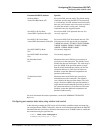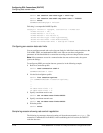
17-4 Preliminary May 9, 2000 APX 8000/MAX TNT/DSLTNT Physical Interface Configuration Guide
Configuring DSL Connections (DSLTNT)
DSL configuration
For complete details of configuring authentication or Frame Relay and PPP connections on
your DSLTNT, see the APX 8000/MAX TNT/DSLTNT WAN, Routing and Tunneling
Configuration Guide and the APX 8000/MAX TNT/DSLTNT Frame Relay Configuration
Guide.
DSL configuration
You configure DSL connections in much the same way you configure ISDN or modem
connections. DSL connections can be configured as switched or nailed PPP, MP, or MPP, or as
Frame Relay-encapsulated connections. You can also use your existing authentication
methods, such as RADIUS, to authenticate DSL users, by using PPP protocols in conjunction
with PAP or CHAP. You can do this either when the units are first turned on or by setting an
inactivity timer.
Any ISDN TA or router (such as a Lucent Pipeline) that supports ISDN BRI (2B1Q) signaling
can be connected over an IDSL connection. ADSL and SDSL connections require Ascend
DSLPipe units on the remote end.
DSL connections require the following general configuration on the DSLTNT:
• The DSL port in the line profile
• A Connection profile for the remote device
• For Frame Relay connections, a Frame Relay profile
In addition to standard routing connections, you can configure the following DSL-specific
capabilities:
• DSLPipe plug and play
• IDSL voice support
Note: For better system performance, Lucent recommends that you enable only DSL ports
that are in use, (By default, DSL ports are disabled.)
Configuring switched connections
A DSL physical link is always up, but a PPP session can be established and terminated based
on data activity, just as it is for ISDN or PSTN calls. Each PPP session initiates negotiations,
followed by authentication and accounting. Switched connections can provide per session
authentication as well as accounting information typically used for client billing.
From the service provider perspective, a DSL connection is handled exactly like an ISDN or
PSTN call. The DSLTNT checks the Answer-Defaults profile, applies authentication methods,
and establishes the PPP session. After some inactivity, the PPP session is dropped, again
generating accounting information. DSLPipe units initiate all switched ADSL and SDSL
connections, and the DSLTNT handles them as regular incoming PPP calls. Note that Frame
Relay connections must be nailed.
You configure the DSLPipe for a switched connection in a similar way to other Pipeline
switched connections, with the following important differences:
• Set the Chan Usage parameter in the Configure profile to Switch/Unused (for ADSL or
SDSL connections) or Switch/Switch (for IDSL connections).



